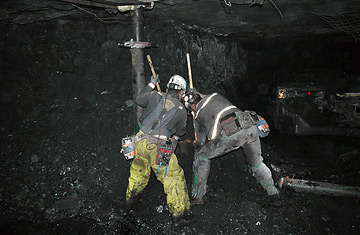
Rescue workers attempt to clear the passageway of the Crandall Canyon Mine in an effort to reach six trapped miners inside.
Mining engineers call it a "bump," but that seems like far too tame a term for what happened at the Crandall Canyon mine in Utah Thursday night. As rescuers tried to dig down to where six coal miners have been trapped since Aug. 6, the walls of their tunnel exploded inward violently, hurling projectiles of rock and coal at the workers. The awful result: two rescue workers and a federal mine inspector are dead, and several more are in the hospital.
All attempts to reach the trapped miners were halted immediately, and Utah Governor John Huntsman urged that they be called off completely. It's not his decision — that's in the hands of the federal Mine Safety and Health Administration (MSHA) — but it may be the only choice. When the original disaster happened 11 days ago, the six original miners were caught some 2,000 ft. from the entrance. That pretty much ensured that it would take a long time to reach them: rescuers essentially have to re-excavate the entire entrance tunnel, now filled with rubble — and do it with extraordinary care. That's because this particular mine is an old one. "You have increased risk," says Davitt McAteer, vice president of Wheeling Jesuit University in West Virginia and a former MSHA assistant secretary, "because you've already disturbed the ground quite substantially."
In response to being riddled with holes, the mountain settles, like a house settling into its foundations — and because the rock is largely sandstone, it's not as rigid as, say, granite might be. Dig new tunnels, as the Murray Energy Corp. has been doing in a process called "remining," and you weaken the mountain still further. That's almost certainly what caused the original collapse (company president Robert Murray insisted it was an earthquake long after professional seismologists concluded it wasn't).
So the rescuers had to move very slowly, shoring up the walls and ceilings as best they could — an unconscionable situation, says McAteer. "If we cannot get to miners in a faster, quicker and safer way then we ought not to be engaging in mining where the risks are so great. We should not permit mining at that level of risk." Indeed, it was the long delay in getting to miners that caused 12 deaths in the Sago coal mine disaster in January 2006. In that case, there was no collapse, but rather an explosion in the West Virginia mine. If those miners had had outside communication, they might have known that their way out was unblocked and that no fire was in their path, that they could have walked out easily. Instead, they built a barricade to protect against toxic air, hunkered down and waited for rescue — but it never came, as mine officials were slow to gather a crew and to enter tunnels whose safety they couldn't ascertain. The 12 miners died of carbon monoxide poisoning.
In the aftermath of that tragedy, federal law was rewritten to require miners to have wireless communication systems, and to provide them with respirators containing more than the one hour of oxygen the Sago miners had. But the law hasn't gone into effect yet, and it wouldn't have speeded up the rescue effort in this case. The rescuers had only gone about 800 ft. by yesterday evening — and there's no reason to believe the trapped miners are alive, or that they even survived the first collapse. Boreholes drilled from above into the chambers where the miners might have found refuge found no evidence of life at all — only, yesterday morning, a faint vibration picked up by a microphone lowered into one of the holes. But the sound could have come from animals, or shifting rocks.
Better communication devices could at least have pinpointed the miners' location, letting mine officials drill down to get them food, water and air. Could the miners possibly be alive? "It's feasible," says Carol Raulston, of the National Mine Association. There could be pockets of air for them to breathe. Beyond that, she says, "there's water in the mine, and people have been known to survive this long without extra food." Indeed, every time a major earthquake levels a city, rescuers always seem to pull one last victim out of the rubble long after any reasonable hope was gone.
In this case, though, the danger to the rescuers is so great that at some point, the dwindling chance of finding anyone alive tips the risk-benefit equation in favor of giving up. Yesterday's tragedy may have been that tipping point.
Reported by Katie Rooney
